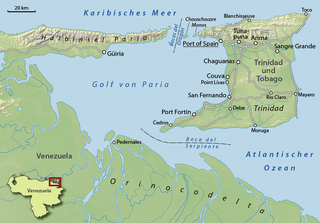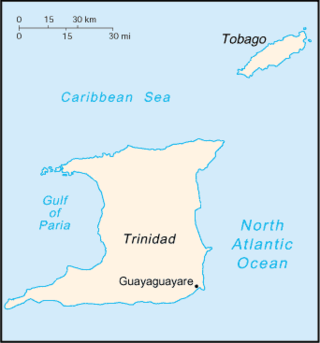| Type | Public |
|---|---|
| Industry | Natural Gas |
| Founded | 1975 |
| Headquarters | , |
| Products | Natural Gas |
| Website | www.ngc.co.tt |
The National Gas Company of Trinidad and Tobago Limited (NGC) is a state-owned natural gas company. It was created by the Government of Trinidad and Tobago in 1975. NGC operates in the field of gas pipelines, industrial sites, gas production, port and marine infrastructure, natural gas liquids and liquefied natural gas. It has assets worth $43 billion. Its credit rating by Moody's is Baa2 and A− from S&P The company currently operates in Point Lisas, Couva at the Point Lisas Industrial Estate.

The economy of Trinidad and Tobago is the third wealthiest in the Caribbean and the fifth-richest by GDP (PPP) per capita in the Americas. Trinidad and Tobago is recognised as a high-income economy by the World Bank. Unlike most of the English-speaking Caribbean, the country's economy is primarily industrial, with an emphasis on petroleum and petrochemicals. The country's wealth is attributed to its large reserves and exploitation of oil and natural gas.
Trinidad and Tobago, a country that relies heavily on industrialisation and tourism, has various transport systems.
NGC may refer to:

Trinidad is the larger and more populous of the two major islands of Trinidad and Tobago. The island lies 11 km (6.8 mi) off the northeastern coast of Venezuela and sits on the continental shelf of South America. It is often referred to as the southernmost island in the West Indies. With an area of 4,768 km2 (1,841 sq mi), it is also the fifth largest in the West Indies.

Arima, officially The Royal Chartered Borough of Arima is the easternmost and second largest in area of the three boroughs of Trinidad and Tobago. It is geographically adjacent to Sangre Grande and Arouca at the south central foothills of the Northern Range. To the south is the Caroni–Arena Dam. Coterminous with Town of Arima since 1888, the borough of Arima is the fourth-largest municipality in population in the country. The census estimated it had 33,606 residents in 2011.

The Gulf of Paria is a 7,800 km2 (3,000 sq mi) shallow semi-enclosed inland sea located between the island of Trinidad and the east coast of Venezuela. It separates the two countries by as little as 15 km at its narrowest and 120 km at its widest points. The tides within the Gulf are semi-diurnal in nature with a range of approximately 1m. The Gulf of Paria is considered to be one of the best natural harbors on the Atlantic coast of the Americas. The jurisdiction of the Gulf of Paria is split between Trinidad and Venezuela with Trinidad having control over approximately 2,940 km2 (1,140 sq mi) (37.7%) and Venezuela the remainder (62.3%).

Petroleum Company of Trinidad and Tobago Limited was a state-owned oil company in Trinidad and Tobago. Its principal activities were the exploration, development and production of hydrocarbons in addition to the manufacturing and marketing of petroleum products.

Guayaguayare is the southeasternmost village in Trinidad & Tobago. It lies at the southern end of the county of Mayaro. Guayaguayare is primarily a fishing village, but it also plays a major role in the petroleum industry. The largest petroleum producers in the country - BP Trinidad & Tobago (bpTT), BHP and Petrotrin all have major presences here and bpTT controls the Port of Guayaguayare, which services most of the offshore petroleum production in Trinidad. The major natural gas pipelines, serving Atlantic LNG in Point Fortin and the Point Lisas Industrial Estate, come ashore here.
Couva is an urban town in west-central Trinidad, south of Port of Spain and Chaguanas and north of San Fernando and Point Fortin. It is the capital and main urban centre of Couva–Tabaquite–Talparo, and the Greater Couva area includes the Point Lisas industrial estate and the port of Point Lisas. It is one of the fastest-growing towns in the country. Couva's southern boundary is at the village of California and Point Lisas, and to the north Couva stretches to McBean. To the east of Couva is Preysal. To the west of Couva is the road to Waterloo and Carli Bay, which are located on the Gulf of Paria. Couva was part of the Caroni County. Couva is considered a major power base for the United National Congress, whose headquarters was previously located here.

La Brea is a town in southwestern Trinidad, located northeast of Point Fortin and southwest of San Fernando. La Brea is best known as the site of the Pitch Lake, a natural asphalt lake. Pronunciation of "La Brea" differs from that used in the USA at the La Brea Tar Pits in Los Angeles. Trinidadians call this place "La Bray".

Point Lisas is a major industrial centre in Trinidad and Tobago and is host to the Point Lisas Industrial Estate and the Port of Point Lisas, both of which are managed by Plipdeco. Point Lisas is located in Couva, Trinidad and Tobago and on the Gulf of Paria coastline.

Trinidad and Tobago, officially the Republic of Trinidad and Tobago, is the southernmost island country in the Caribbean. Consisting of the main islands Trinidad and Tobago and numerous much smaller islands, it is situated 11 kilometres off the coast of northeastern Venezuela and 130 kilometres south of Grenada. It shares maritime boundaries with Barbados to the east, Grenada to the northwest, Saint Vincent and the Grenadines to the north and Venezuela to the south and west. Trinidad and Tobago is generally considered to be part of the West Indies. The island country's capital is Port of Spain, while its largest and most populous city is San Fernando.
Trinidad and Tobago Electricity Commission (T&TEC) is the sole retailer of electricity in Trinidad and Tobago. It is responsible for the design, construction, operation and maintenance of the country's electrical transmission and distribution network. The utility supplies electric power to customers on both islands via a single interconnected grid. Electrical energy is widely been purchased, metered and feed into the national grid from independent power producers. These producers are the Power Generation Company of Trinidad and Tobago (PowerGen) giving a total of 1,344 MW, Trinidad Generation Unlimited (TGU) giving 720MW and Trinity Power Ltd. giving 225 MW. All power stations in Trinidad and Tobago are fueled by hydrocarbons.
The Eastern Caribbean Gas Pipeline is a proposed natural gas pipeline from Tobago to other eastern Caribbean islands.
The Atlantic LNG Company of Trinidad and Tobago is a liquefied natural gas (LNG) producing company operating a liquefied natural gas plant in Point Fortin, Trinidad and Tobago. Atlantic LNG operates four liquefaction units (trains). Train 4, with a 5.2 million tonnes per year production capacity, is among the world's largest LNG trains in operation.
California is a neighbourhood located south of Downtown Couva, within the Couva–Tabaquite–Talparo regional corporation, Trinidad and Tobago. It is bordered on the west by the Point Lisas Industrial Estate and to the East by the University of Trinidad and Tobago. Dow Village and Esperanza Village are within California.
The NGC Bocas Lit Fest is the Trinidad and Tobago literary festival that takes place annually during the last weekend of April in Port of Spain. Inaugurated in 2011, it is the first major literary festival in the southern Caribbean and largest literary festival in the Anglophone Caribbean. A registered non-profit company, the festival has as its title sponsor the National Gas Company of Trinidad and Tobago (NGC). Other sponsors and partners include First Citizens Bank, One Caribbean Media (OCM), who sponsor the associated OCM Bocas Prize for Caribbean Literature, CODE, and the Commonwealth Foundation.
The Loran–Manatee gas field natural gas field is located on the continental shelf of the Atlantic Ocean. It was discovered in 1983 and developed by PDVSA. It began production in 2013 and produces natural gas and condensates. The total proven reserves of the Loran–Manatee gas field are around 10.25 trillion cubic feet (293 km3), and production is slated to be around 750 million cubic feet/day (21,4×106m3) in 2018.
Güiria is the capital city of Valdez Municipality in the Venezuelan state of Sucre. Güiria was the place where the military campaign for South American independence set out to Upper Peru and also a starting point of the 1901 Venezuelan Civil War. Founded on 8 December 1767, Güiria is the state's third-largest urban centre, with a population of approximately 40,000. It is an important harbour, the only one in Venezuela located on the open Atlantic Ocean rather than on the Caribbean Sea, and the economic centre of Paria Peninsula, due to it being near the Gulf of Paria's natural gas fields, where several state and private companies have exploration projects.